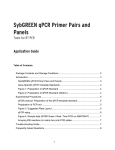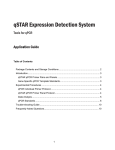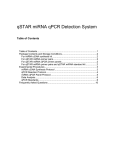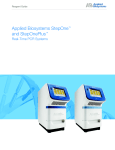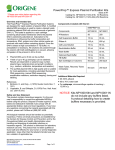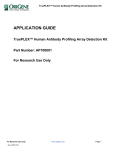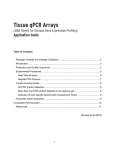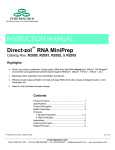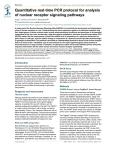Download SybGREEN qPCR Primers and Standards
Transcript
SybGREEN qPCR Primers and Standards Tools for RT-PCR Application Guide Table of Contents Package Contents and Storage Conditions ................................................................. 1 Introduction.................................................................................................................. 3 SybGREEN qPCR Primer Pairs ............................................................................... 3 Gene Specific qPCR Template Standards ............................................................... 3 Figure 1: Preparation of qPCR Standard ................................................................. 4 Figure 2: Preparation of qPCR Standard (dilution)................................................... 4 Experimental Procedures ............................................................................................ 5 qPCR protocol: Preparation of the qPCR template standard ................................... 5 Preparation of PCR mix: .......................................................................................... 5 Figure 3: Suggested Plate Layout ............................................................................ 6 qPCR setup.............................................................................................................. 6 Figure 4: Sample data (SYBR Green I Real -Time PCR on ABI9700HT) ................ 7 Trouble-shooting Guide ............................................................................................... 7 Frequently Asked Questions........................................................................................ 7 Package Contents and Storage Conditions For SybGREEN primer only: 1 • • 1 Vial SybGREEN qPCR primer mix: 2 nmol lyophilized (sufficient for 200 reactions). Before use, reconstitute the primer mix in 200 µl dH2O to make a final concentration of 10 uM. Application Guide For SybGREEN primer and qPCR standard kit: • 1 Vial SybGREEN qPCR primer mix: 2 nmol lyophilized (sufficient for 200 reactions) • 1 Vial Gene Specific qPCR template standard: 50 X 107 Copies** (double-stranded DNA) lyophilized. Add 50 μl of d H2O to the tube and vortex briefly. The resuspended template is 10,000,000 copy/μl. • 1 Vial containing 1 mL 10 x PCR template standard dilution buffer. • Application guide. The above components are shipped at room temperature, but should be kept at -20°C for long-term storage. If properly stored, they have a 12-month shelf life. * The polymerase chain reaction (PCR) is protected by patents held by Hoffmann-La Roche. Purchase of any of OriGene’s PCR-related products does not convey a license to use the PCR process, covered by these patents. Purchasers of these products must obtain a license before performing PCR. ** see page 6 on how to calculate the copy number of an unknown sample. NOTE: FOR RESEARCH PURPOSES ONLY. NOT FOR DIAGNOSTIC OR THERAPEUTIC USAGE. -2- Introduction Real time PCR is one of the most important approaches in detecting the transcript level of a gene in a particular cell or tissue sample. Two types of real time PCR protocol are currently used. One is probe based and the other is SYBR Green I based. The two protocols utilize fluorescent probes or dyes that are proportional to the amount of the PCR products generated at the end of each cycle. Differences between the two methods involve the types of fluorescent signals and the ways in which the signals are generated. In the TaqMan protocol, a pair of gene-specific amplification primers and a sequence-specific, fluorogenic probe is present in the PCR mixture. During amplification, the probes anneal proportionally to the single strand amplicons and are subsequently removed base-by-base by the 5’ exo-nuclease activity of Taq polymerase. Consequently, the released fluorescence moiety generates fluorescent signals that are proportional to the amount of PCR product generated. This method is very sensitive and reliable. The SYBR Green I protocol, on the other hand, does not require a sequence-specific fluorescent probe. SYBR Green I binds to double stranded DNA to generate detectable fluorescence, and the amount of signal is proportional to the amount of double-stranded DNA present. Since SYBR Green I binds indiscriminately to double-stranded DNAs, it will generate false signals if non-specific DNA contamination exists. Nevertheless, it is frequently used in many laboratories due to its simple protocol and low cost. SybGREEN qPCR Primer Pairs The key components of a successful qPCR are the primers used to amplify the template. Only welldesigned primers can give trustworthy expression data using qPCR. Poor primer design usually results in non-specific PCR products and/or primer dimers. These undesired DNA byproducts will interact equally well with SYBR Green reagents, and therefore generate a false positive signal. To design primers with a high specificity and a low incidence of primer dimer formation, OriGene conducted a large scale study of qPCR involving thousands of primers. Based on the vast PCR data acquired through this study, OriGene scientists were able to develop a superb primer design algorithm. With this algorithm, OriGene is able to provide our customers with genome wide pre-designed, ready-to-use qPCR primers. Besides high specificity and high efficiency, each primer pair is also selected to span exon junctions whenever possible, thus avoiding the amplification of genomic DNA. Each primer pair is supplied as 2 nmol lyophilized powder. Before use, reconstitute the primer mix in 200 µl dH2O to make a final concentration of 10 uM. Gene Specific qPCR Template Standards A known qPCR template standard serves two main purposes. It functions as a positive control and as a reference for measuring the exact copy number of a transcript in an unknown sample. OriGene has a large collection of full-length human and mouse cDNA constructs which are ideal PCR templates. To increase the accuracy of DNA quantification, a full-length cDNA is purified using high purity ion-exchange columns, linearized by a restriction enzyme and quantified by the Picogreen method. The Picogreen method relies upon an ultra-sensitive fluorescent nucleic acid stain and has a much higher accuracy than a UV spectrophotometer for determining DNA concentration. The process for the preparation of a qPCR standard is illustrated in Figure 1. -3- Figure 1: Preparation of qPCR Standard A B 230000 220000 210000 200000 190000 y = 3511.6x 180000 R = 0.9926 2 170000 160000 150000 140000 130000 120000 110000 100000 90000 80000 70000 60000 50000 40000 30000 20000 10000 0 0 5 10 15 20 25 30 35 40 45 50 55 60 65 A. An EcoRI linearized qPCR template standard is run on a 1% agarose gel. B. Plot of a template DNA and PicoGreen standard from a PicoGreen assay. The concentration of the template DNA is converted from ng per μl to copy number per μl using the following formula: (C * 10-9 / MW) * NA (C: template concentration ng/μl, MW: template molecular weight in Daltons, NA: Avogadro's constant, 6.022 x 1023) Figure 2: Preparation of qPCR Standard (dilution) 10 μl 10 μl 10 μl 10 μl 10 μl 10 μl Stock 1 x 107 /ul 90 μl 1 2 3 4 106 105 104 103 -4- 5 6 102 10 1 copy/ul Experimental Procedures qPCR protocol: Preparation of the qPCR template standard 1. The qPCR template standard is provided as a dried pellet. Add 50 μl of d H2O to the tube and vortex briefly. The resuspended template is 10,000,000 copy/μl. Thaw the 10 x dilution buffer tube from the kit at room temperature. 2. If the SYBR Green I method is used, reconstitute SybGREEN primer by adding 200 μl d H2O to the primer tube and vortex it briefly. The resuspended primers are 10 pmol/ul each. (Omit this step if Taqman probe method is used) 3. Prepare 1.0 mL of 1 x dilution buffer by adding 100 μl of the 10 X buffer to 900 μl H2O. 4. Label six (6) Eppendorf tubes from 1 to 6. Transfer 90 μl of 1x buffer to each pre-labeled eppendorf tube (1 to 6). 5. Transfer 10 μl of template standard from the stock tube to eppendorf tube #1 (Fig. 2). Mix the solution by briefly vortexing. 6. Transfer 10 μl solution from tube #1 to tube #2, then mix the solution by vortexing.. 7. Perform remaining dilutions by repeating steps 5 and 6. 8. Transfer 5 μl of diluted template solution from each tube to a 96-well PCR plate (use 2 μl when a 384-well plate is used). Preparation of PCR mix: The qPCR template standard can be used with either the Taqman probe based method or the SYBR Green I method. Step one, calculate the total volume of the PCR mixture based on the number of the total samples. The following recipes are for setting up a cocktail for 60 samples (6 template standard dilutions in duplicate and 48 unknown samples). The qPCR reaction volume is 25 μl volume in 96-well format for both the SYBR Green method and the Taqman probe method: When the 384-well format is adopted, reduce all reagents proportionally. The recommended reaction volume for 384 is 10 μl. SYBR Green I method Prepare the cocktail as follows: 64X solution 2 x Master mix Primer mix H20 800 μl 64 μl 416 μl 1,300 μl Taqman probe method Probe method 2 x Master mix 20 x Taqman Probe * with the gene specific primers included 800 μl 80 ul H20 420 μl 1,300 μl -5- Figure 3: Suggested Plate Layout PCR standard Unknown Empty well qPCR setup 1. Transfer 5 μl of each of the six qPCR Template Standard dilutions to Row A in duplicate 2. Add 5 μl of each unknown sample to row C, D, E and F. The amount of cDNA in each reaction is ideally around 1 to 10 ng, diluted with the dilution buffer included. 3. Add 20 μl of PCR cocktail to each of well of row A, C, D, E and F. 4. Seal the PCR plate with a real time PCR sealer. 5. Mount the plate to a real time PCR machine, such as ABI 7900HT. 6. Set up the PCR run according to the machine’s user manual. Be sure to input the copy number when setting up the PCR standards (using the standard curve method). 7. Start the PCR reaction. 8. Analyze the data according to the machine’s user manual. Calculation of the copy number of your gene of interest 1. 2. If the cDNA templates in your samples are single-stranded such as cDNA from RT reactions, the actual copy number of your gene of interest is two times the number you got by comparing to the qPCR standards. For example, if the copy number of your gene is 5 copy/μl from the standard curve of a qPCR program, the actual number is 10 copy/μl. The reason is that the first cycle for a single-stranded sample is to make the complementary strand; therefore, there is one cycle delay in the PCR reaction compared to the double-stranded cDNA template standard’s reaction. If the templates in your samples are double-stranded, the copy number of your gene of interest is the same as that calculated according to the qPCR standards. -6- Figure 4: Sample data (SYBR Green I Real -Time PCR on ABI9700HT) qPCR Template Standard and primer pair for NM_004808, Human N-myristoyltransferase 2 (NMT2) Real time PCR data were obtained by using serial dilutions of a PCR standard for NM_004808 as the template with specific primers. The PCR was performed on the ABI 7900HT utilizing the SYBR method. The plot of Δct vs. cycle number for qPCR Template Standard is shown on the left (with copy numbers from 10,000,000 to 10 per μl) and the concentration dilution plot is shown on the right. An unknown sample (breast cancer tissue cDNA) is detected to contain approximately 37 copies/ μl of NMT2 based on the standard curve results. Trouble-shooting Guide No qPCR product detected 1. A qPCR component may have been omitted in the reaction. Be sure to use a checklist when assembling the reaction mix. 2. Make sure the master mix is working by using a positive template control. 3. The sample used may have very limited qPCR template. Add more sample or prepare efficient templates by using a better reverse transcriptase. The standard curve generated is not linear The dilution of the Template Standard may have been done incorrectly. Use an accurate pipette and mix each dilution sample thoroughly. A Ct value is out of the range of the standard curve If the Ct reading for an unknown sample is too small (high abundance of a template), dilute the sample further. If the Ct is too high (low abundance of a template), then dilute the template standard further or use more unknown sample. Frequently Asked Questions Q: What are SybGREEN qPCR Primer Pairs? A: SybGREEN qPCR Primer Pairs are pre-designed, qPCR tested and ready-to-use primer sets for SYBR Green based qPCR experiments. Q: Can SybGREEN qPCR Primer Pairs be used in probe based qPCR? -7- A: No. This kit has not been designed to accommodate any commercial probe based qPCR. Q: What is the Tm of the primer and what is a typical size of the amplicon? A: The Tm of a SybGREEN qPCR Primer is around 60, and the amplicon is around 95 to 140 bp. Q: Does a SybGREEN qPCR Primer Pair amplify an exon junction in a cDNA target? A: Whenever possible, an amplicon by a SybGREEN qPCR Primer Pair covers exon junction or junctions. Q: What is a qPCR template standard? A: A gene specific qPCR template standard is a tube of linear DNA made from a full-length cDNA plasmid. The copy number of a template standard solution is determined by the PicoGreen method and calculation based on MW. Q: Can a template standard be used in a probe-based qPCR? A: Yes, as long as a corresponding probe is used. Q: In your protocol, it is recommended to make six serial dilutions with one log of difference, can I make more dilutions and with different dilution scheme? A: Yes, as long as it is diluted in the qPCR detection range and each dilution is mixed thoroughly. Q: Can I use my own buffer to dilute the template standard instead of the buffer in the kit? A: Yes, as long as the buffer has no negative effects on qPCR. Q: Does OriGene offer custom-made template standards? A: Yes. Please contact our Tech Support at [email protected] Q: What is the OriGene guarantee on qPCR primers and template standards? A: OriGene qPCR primers and templates are warranted for SYBR Green qPCR experiments. If your experimental results are not satisfactory, our scientists will work with you to pinpoint the problem and, if it is determined that our products are at fault, OriGene will refund your money in the form of a credit. -8-








